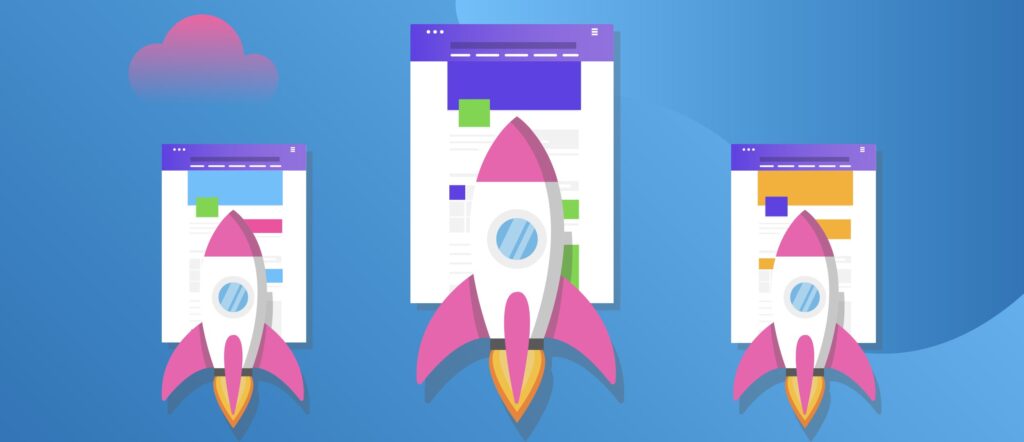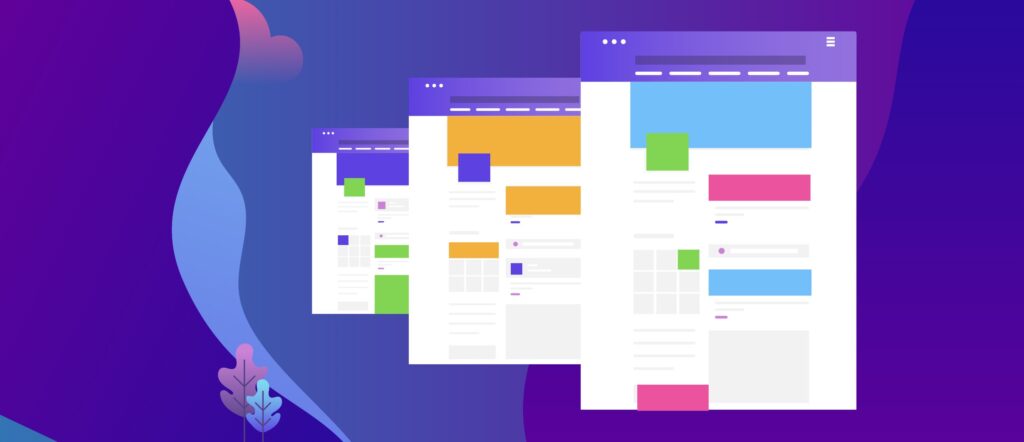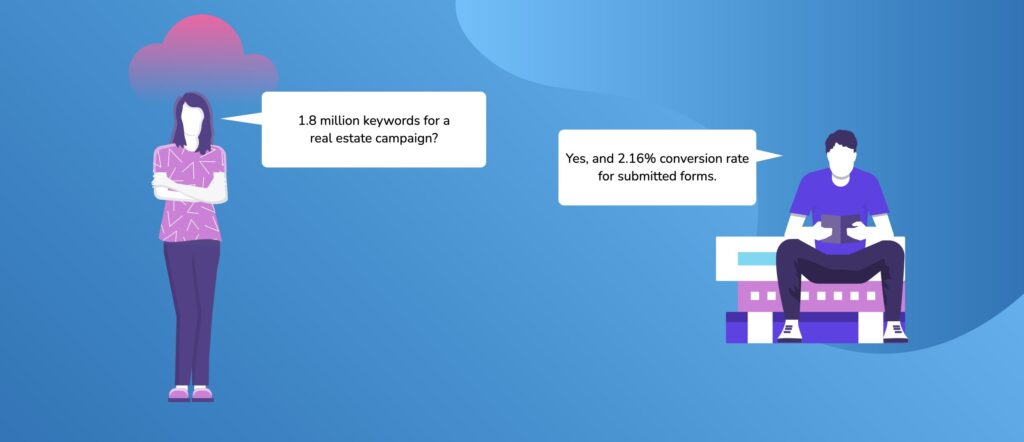
A SEA campaign architecture – what is it anyway?
One of the most prominent strategies in online marketing is search engine advertising, often known by the acronym SEA (Search Engine Advertising). SEA allows companies to place targeted ads on search engines like Google, Bing, or Yahoo, thereby being present at the right moment for users who are actively searching for specific products, services, or information. Although the basic idea of SEA may seem simple, it sometimes hides surprising complexity that requires thorough knowledge and expertise in multiple areas.
In this article, we shed light on the structure of SEA campaigns from different perspectives and specifically address the individual areas. We also show how the aforementioned complexity can be addressed in large campaigns with a holistic approach – a so-called SEA campaign architecture.
The central topics of SEA
The setup of SEA campaigns is characterized by three central elements: the keyword world, the ad creation, and the landing page design. Each of these areas has its unique characteristics.
The keyword world forms the foundation of an SEA campaign and, if defined correctly, leads to ads being presented to the right users at the right time. The ad creation, the next step, focuses on attracting the user’s attention after the ad is displayed and encouraging them to click. Finally, the design of the landing page, a central element of the conversion funnel, plays a crucial role in transforming this click into an actual conversion. Therefore, the overall effectiveness of an SEA campaign depends on each of these areas and requires careful planning and execution.
The keyword world: The heart of every SEA campaign
Selecting the right keywords (search terms) is the first and perhaps most important step in any SEA campaign. The complexity arises from the sheer number of options and considerations that must be incorporated into the keyword selection.
An effective keyword must not only reflect the search behavior of the target audience but also match the company’s offerings. Some keywords may have high search volume but may be too generic or irrelevant to what the company actually offers. Others may be relevant but have such low search volume that they generate little to no traffic. And then there are the so-called “long-tail” keywords – more specific, longer combinations of keywords that may have fewer searches but often have a higher conversion rate.
An example: A real estate agent offers a variety of properties in various locations, such as throughout Germany or even worldwide. While keywords like “property” or “property listing” may be frequently searched but too vague for your own offer, as both buyers and sellers are meant, the keyword “buy property Hamburg” is much more specific. With a further addition, for example, “buy property Hamburg financing,” the search query becomes even more specific – one is in the aforementioned long-tail.
And if you then realize that you don’t just want to compete for the interchangeable word “properties” because you also – like one of our clients – sell farmyards, water towers, forest houses, lakefront properties, apple orchards, and boat houses – go ahead! You then advertise these terms without competition. This is because your competitors do not have suitable landing pages for them. Because your campaign architecture must also be able to deliver this. But more on that in a moment.
Moreover, marketers also need to consider the costs. Some keywords are highly contested, meaning that bidding on them can become expensive. This is particularly the case with keywords that consist of only one or two words (the so-called “short-head”) – as the owner of a sneaker store, for example, you can assume that you will have to compete with Adidas, Nike, and Co. for the keyword “sneaker.” This, of course, also applies to other business fields. Therefore, a balancing act is necessary to find the right ratio of cost, relevance, and search volume.
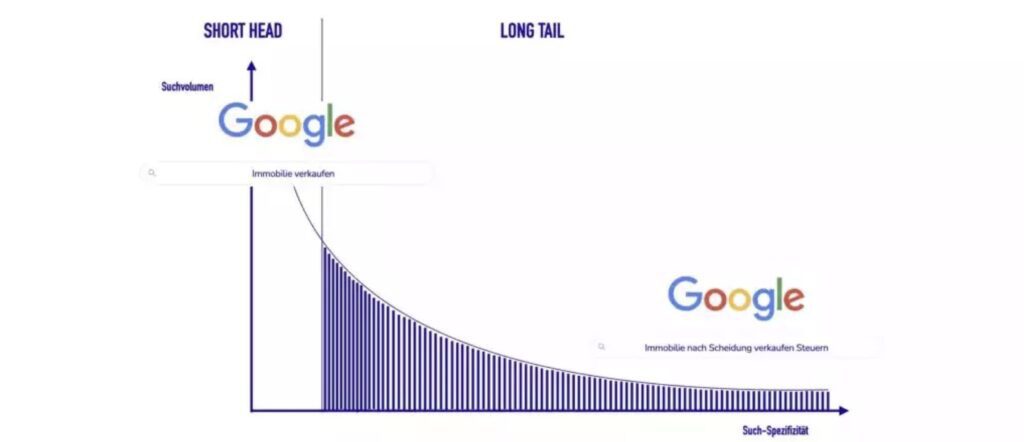
Ad Creation: The Art of Attracting Attention
Once the right keywords have been identified, the challenge is to create effective ads for them. Here, companies must present their products and services in a few words, thereby arousing the user’s interest and prompting them to click.
The ad texts must be clear, concise, and appealing. Furthermore, they should be equipped with strong Call-to-Action elements (CTAs) to motivate the user to perform a specific action, whether it is a purchase, a registration, or other actions relevant to the company. “Sign up for the newsletter now” or “Strike now in our sale” are two striking examples here.
It is also important to note that SEA ads often appear in a competitive environment, right next to ads from competitors who are advertising for the same customers. Therefore, companies must find ways to positively stand out, in addition to efficiently designing the ad texts.
Landing Pages: More Helps More
After a user has clicked on an SEA ad, they are usually redirected to a special webpage, the so-called landing page. The design, user-friendliness, and content offered on this page are of great importance for the success of the entire campaign, as a good Click-Through Rate (CTR) on the ad is literally worthless if the desired conclusion is not reached at the end of the User Journey.
However, this is crucial: each of your landing pages must exactly match the switched ad. It only does if it contains all the relevant information advertised with the ad and which the user needs for an informed decision.
So if you have opted for a competitive or non-competitive and large – perhaps even long-tail – keyword world in the first step, then you are also dealing with a large number of ads. Therefore, you need something like a landing page generator at this point. This should also be part of a comprehensive campaign architecture.
It should also contain clearly defined CTAs and lead the user on a seamless journey from the ad to the desired action.
Effects on Campaign Performance
A well-thought-out keyword selection, coupled with effective ads and landing pages tailored to them, can significantly increase the success of an SEA campaign. Through precise keyword selection and successful ad creation, you reach exactly those users who have a high affinity for the advertised product or service, thereby minimizing wastage and increasing the click rate.
When the user is then redirected to a landing page that seamlessly continues the content of the ad or processes the information offered there in more detail, a consistent user experience is offered. This promotes trust and increases the conversion rate, which ultimately leads to more efficient use of the advertising budget, a higher Return on Investment (ROI), and ultimately increased sales for the advertising company.
Challenges in Managing the Three Areas
In large and complex SEA campaigns, the complexity and potential for inefficiencies increase with the number of keywords, ads, and landing pages. To achieve outstanding Key Performance Indicators (KPIs), the landing page must exactly match the ad. Each landing page is therefore different because it must have precisely explanatory content for each keyword, both at the ad and especially at the landing page level (illustrated in the following screenshot).
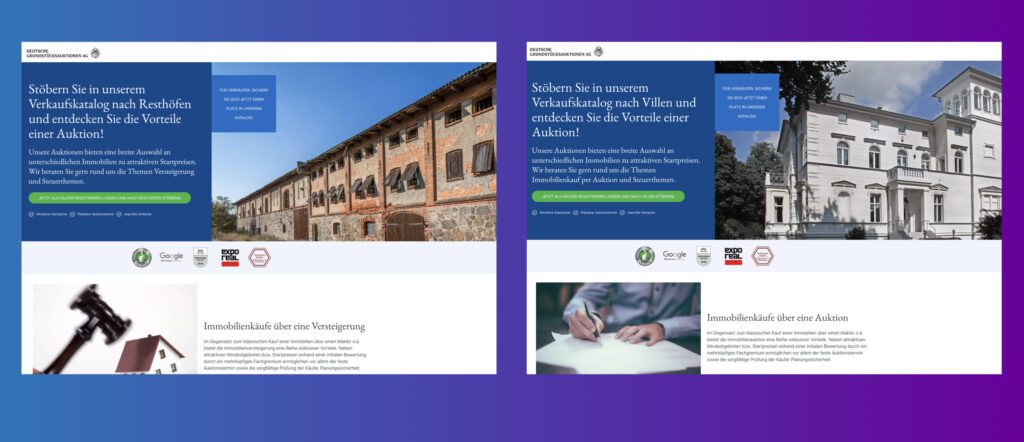
While the design options for the ads are limited by the maximum number of characters in titles and texts, there are no such restrictions on the landing page. The required diversity is therefore particularly necessary here. But is the effort then in a healthy ratio to the yield?
Informational and Navigational Beat Transactional in Return on Ad Spend (ROAS)
This is particularly the case with so-called informational search queries, i.e., those that expect more detailed information about a product or topic area, or navigational search queries, e.g., after geographical locations. For example, someone looking for a hearing aid will most likely want to test it on-site first – and is therefore logically looking for it with the search query “test hearing aid [city]”.
For search queries of these types, we not only record a often hundredfold higher number of ad impressions (impressions) but also a twice as high ROAS (yield vs. campaign costs) compared to purely transactionally oriented campaigns.
Nevertheless, advertisers often tend to focus only on specific parts of the offer (bestsellers) instead of depicting the entire diversity. Highly sought-after informational and navigational inquiries are left out entirely. A quite understandable aversion to effort, but it leaves a lot of potential untapped.
Therefore, a solution would be desirable that not only combines the three central topic areas of SEA campaigns but also overcomes the effort hurdle through automation.
Lyftyfy as a Holistic SEA Campaign Architecture
lyftyfy is the answer to this problem. As a holistic SEA tool, it integrates the creation of both keywords and associated ads and landing pages in an unprecedented, summarizing campaign architecture. This means full control for SEA managers, who can now optimize even very complex campaigns with minimal effort. Thanks to automation, lyftyfy creates tailor-made landing pages for each keyword, so the full potential of each campaign can be used. No matter how large the campaign or how heterogeneous the content presented may be.
Keyword world, ad templates, and landing pages can be viewed and changed at any time from one hand. lyftyfy creates all pages based on the same template to ensure a consistent corporate design, but still allows the integration of specific content for each keyword and its possible combinations (see the following screenshot).
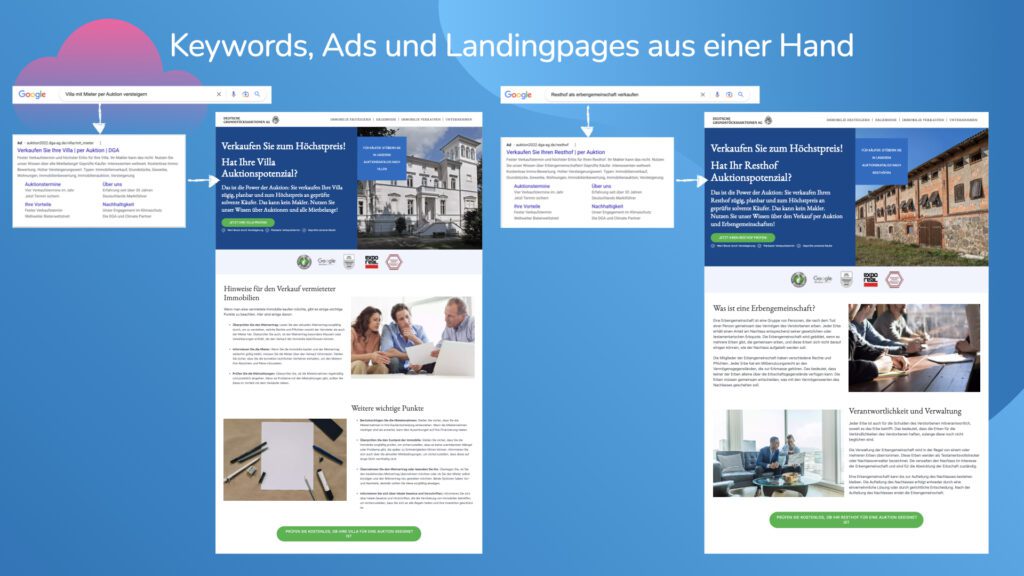
Another example: Imagine you are a logistics service provider offering a variety of services: from international freight transport to warehousing to procurement logistics. With such a comprehensive offer, your SEA campaigns can quickly become complex. If potential customers search for “international freight transport” or “warehousing in [city name]”, you want your ads and landing pages to match these search queries exactly.
If you now create separate landing pages for each of these specific services and geographic locations, the number of pages required quickly becomes uncontrollable. The complexity of your SEA campaigns could increase so rapidly at this point that the workload outweighs the potential benefits. You may be tempted to focus only on the most frequently requested services or geographic regions instead of making the entire spectrum of your services visible on the web.
With lyftyfy, you can automate this complexity of your SEA campaigns. The tool allows you to create tailor-made landing pages for each individual service and location without the additional effort. For example, if someone searches for “night express to Berlin”, they will be directed to a landing page that presents exactly this service in Berlin. So you can individually advertise the entire range of services, regardless of the complexity of the work involved.
Conclusion
The strategic selection of keywords, the creative design of ads, and the optimal execution of landing pages are essential components of a successful SEA campaign. Each of these aspects has its challenges, especially in large-scale campaigns, where the balance between relevance, cost, and search volume becomes increasingly critical.
lyftyfy offers an automated solution that enables even the most extensive campaigns to be managed efficiently and successfully. By linking the three core aspects of an SEA campaign, it reduces wastage and increases both the CTR and the conversion rate, resulting in higher ROI and, ultimately, greater sales success.
